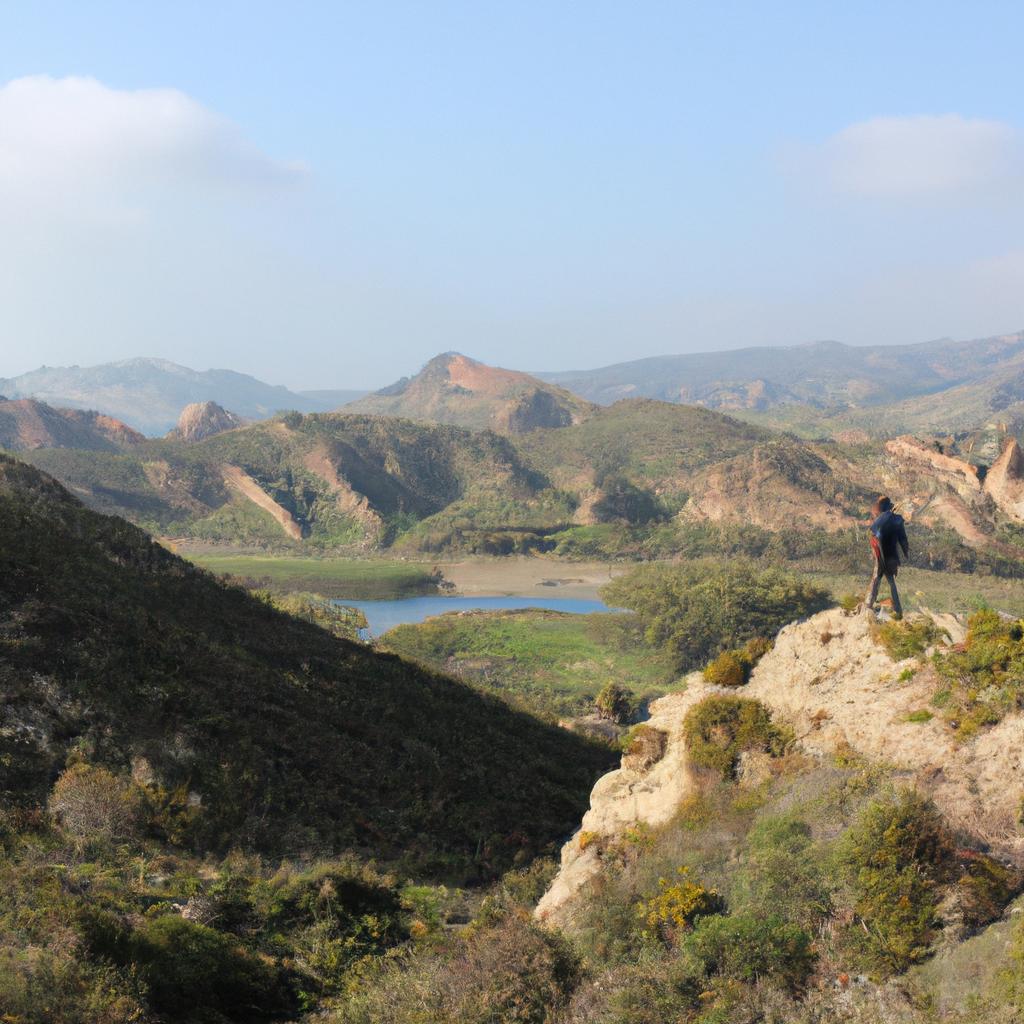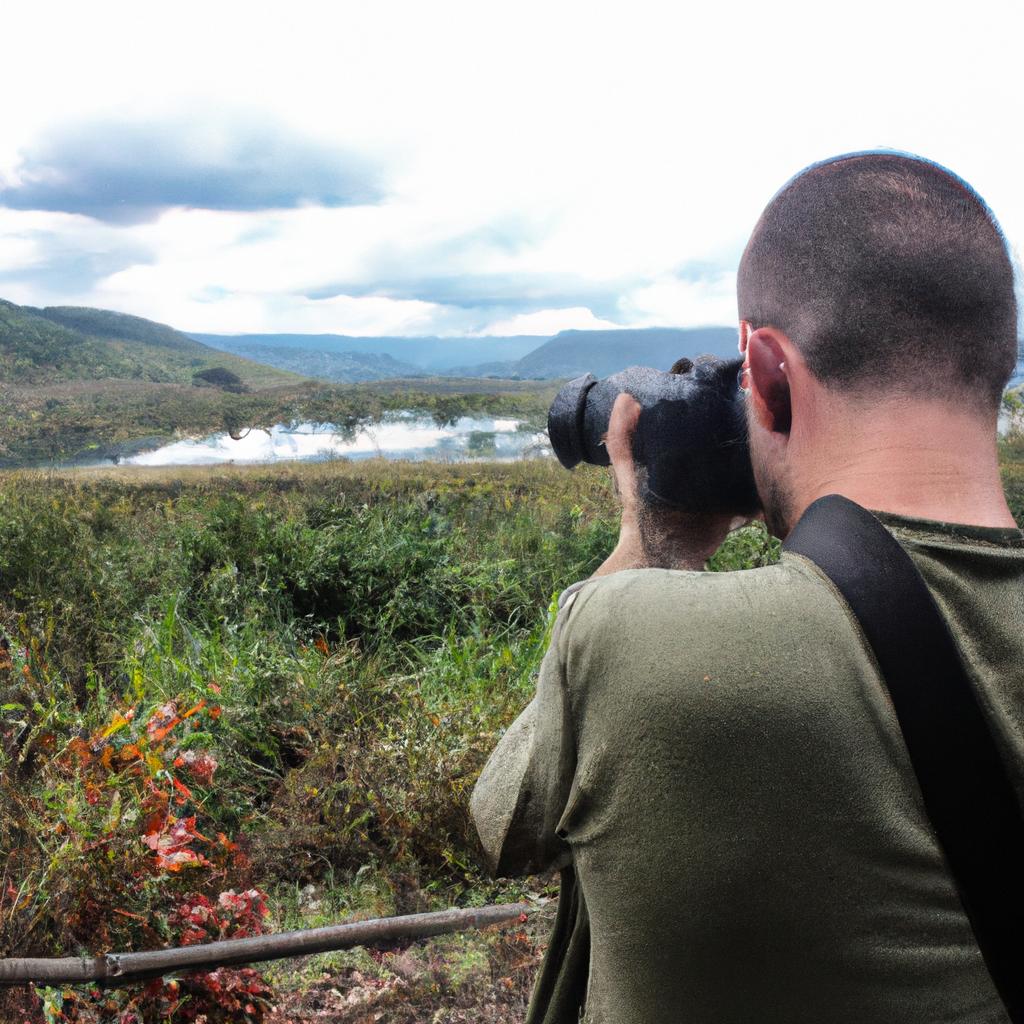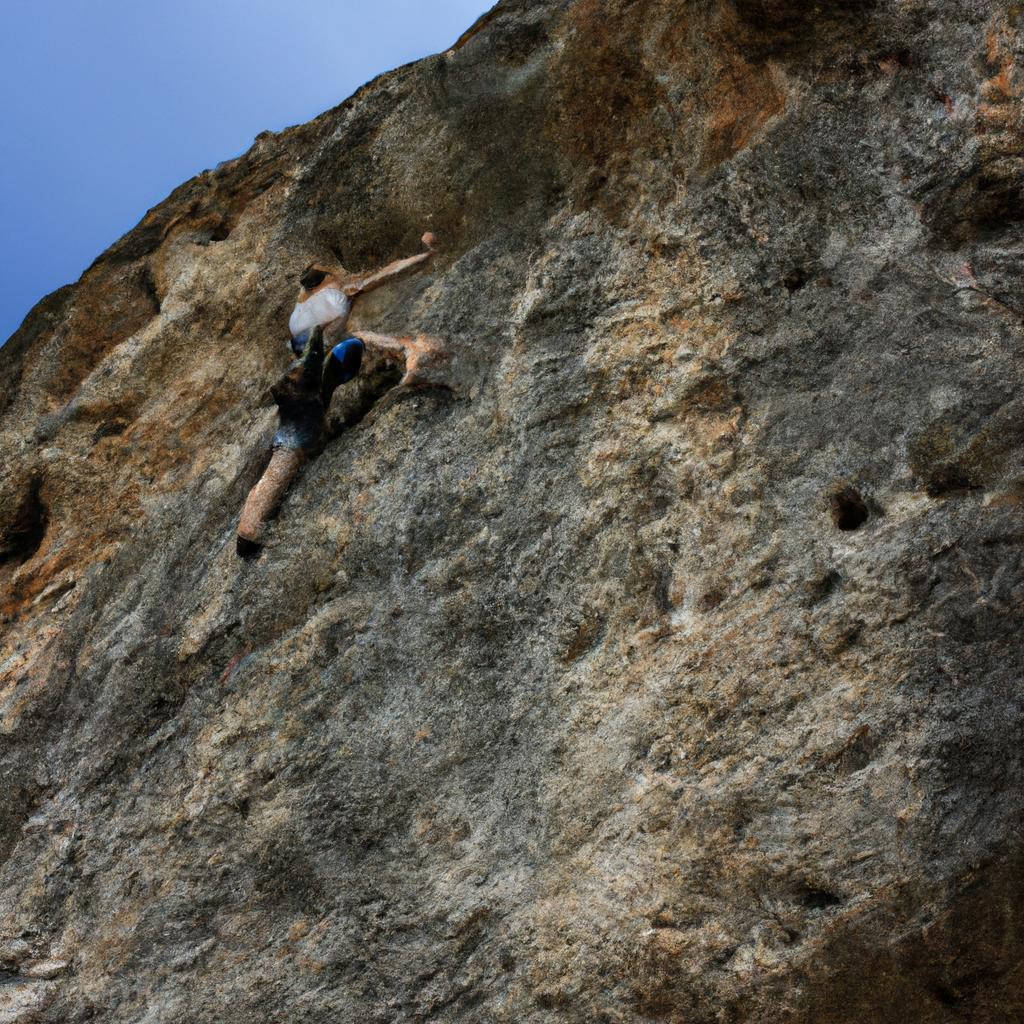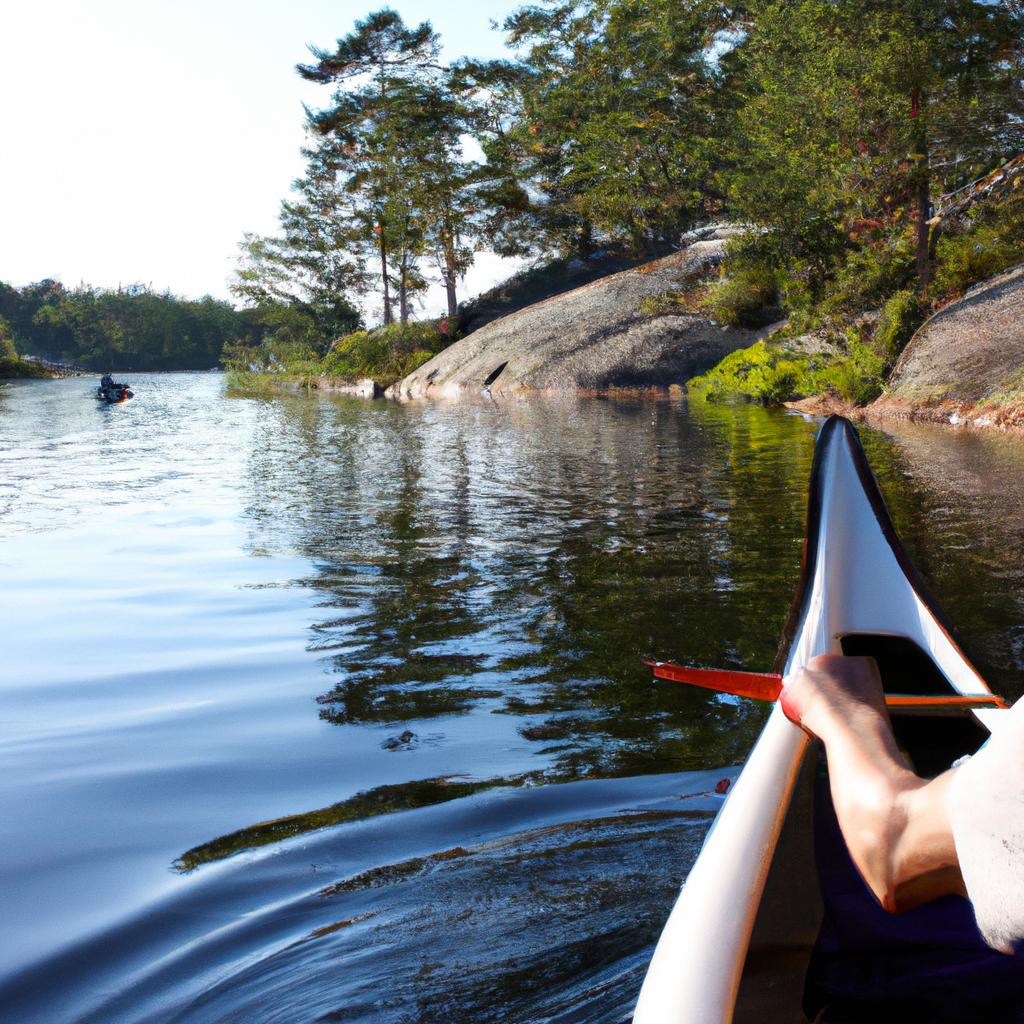Hiking in Travel North America: Outdoor Adventure
Imagine standing at the base of towering mountains, surrounded by lush forests and glistening lakes. The air is crisp, carrying the scent of pine needles and fresh earth. You lace up your sturdy hiking boots, tighten your backpack straps, and embark on a journey to explore the vast wilderness that lies ahead. This scenario exemplifies the allure of hiking in North America – an opportunity for outdoor enthusiasts to immerse themselves in nature’s breathtaking beauty while challenging their physical capabilities.
One such captivating destination for hikers is Yosemite National Park in California. With its iconic granite cliffs, cascading waterfalls, and diverse flora and fauna, it offers unparalleled opportunities for exploration. Hikers can traverse through miles of well-maintained trails ranging from beginner-friendly paths to more demanding routes suited for experienced adventurers. Whether one seeks solitude amidst pristine landscapes or craves camaraderie with fellow trekkers along popular trails like Mist Trail or Half Dome, Yosemite National Park provides an unrivaled experience that epitomizes the essence of hiking in North America.
In this article, we will delve into the world of hiking in Travel North America – exploring its significance as an outdoor adventure activity and delving into some remarkable destinations that showcase the remarkable natural beauty and diversity of the continent. From the rugged peaks of the Rocky Mountains in Canada to the ancient forests of Olympic National Park in Washington, there is no shortage of awe-inspiring landscapes waiting to be discovered.
Hiking in North America offers a unique opportunity to connect with nature on a deeper level. It allows adventurers to escape the hustle and bustle of daily life, immersing themselves in serene surroundings that inspire awe and wonder. The physical challenges posed by hiking also provide an avenue for personal growth and self-discovery. As hikers conquer steep inclines, navigate rocky terrain, or ford rushing rivers, they develop resilience, strength, and perseverance.
One must-visit destination for hiking enthusiasts is Banff National Park in Alberta, Canada. Known for its pristine alpine lakes and breathtaking mountain vistas, it offers an array of trails suitable for all skill levels. Whether you’re looking for a leisurely stroll around Lake Louise or an adventurous multi-day trek along the famous Sunshine Coast Trail, Banff National Park has something to offer every type of hiker.
Another remarkable hiking destination is Zion National Park in Utah. Renowned for its striking red rock formations and deep canyons carved by the Virgin River, Zion offers a variety of trails that showcase its unique geological features. The iconic Angel’s Landing hike provides breathtaking views from atop a narrow ridge while The Narrows allows hikers to wade through water-filled slot canyons for a truly immersive experience.
For those seeking coastal beauty, California’s Big Sur region beckons with its dramatic cliffsides overlooking the Pacific Ocean. Hiking along the rugged coastline reveals hidden coves, secluded beaches, and panoramic vistas that will leave you breathless. Popular trails like McWay Falls Trail or Ewoldsen Trail offer glimpses into this stunning landscape that has captivated artists and writers for generations.
In conclusion, hiking in Travel North America presents outdoor adventurers with an extraordinary opportunity to explore some of the most stunning and diverse landscapes on the planet. Whether you choose to hike through towering mountains, ancient forests, or along picturesque coastlines, each step taken is a chance to connect with nature, challenge yourself physically and mentally, and create memories that will last a lifetime. So lace up your boots, grab your backpack, and embark on an unforgettable journey into North America’s outdoor wonders.
Best Hiking Trails in North America
Picture this: you’re standing at the edge of a breathtaking mountain peak, surrounded by vast expanses of untouched wilderness. The crisp air fills your lungs as you take in the panoramic views that stretch for miles. This is just one example of the awe-inspiring experiences waiting for hikers on some of the best trails in North America.
When it comes to hiking, North America offers an abundance of options that cater to all skill levels and interests. From rugged coastal paths to towering peaks, there’s something here for everyone. To help you plan your next adventure, we’ve compiled a list of some must-visit hiking trails:
-
Appalachian Trail (USA): Stretching over 2,200 miles from Georgia to Maine, this iconic trail winds through charming small towns, lush forests, and majestic mountains. It presents a challenging yet rewarding journey for avid hikers seeking solitude and connection with nature.
-
West Coast Trail (Canada): Located along Vancouver Island’s southwestern coastline, this trail showcases the region’s stunning beauty with its temperate rainforests, hidden coves, and dramatic cliffs. Be prepared for muddy terrain and ladders as you navigate this rugged but unforgettable path.
-
Inca Trail (Peru): Immerse yourself in ancient history as you hike this world-renowned trail leading to Machu Picchu. Traversing diverse landscapes ranging from high Andean passes to cloud forests, each step reveals spectacular archaeological sites steeped in mystery.
-
Torres del Paine Circuit (Chile): Situated within Patagonia’s breathtaking national park, this circuit rewards adventurers with jaw-dropping vistas of towering granite spires and pristine glaciers. Expect challenging conditions such as fierce winds but relish in the raw beauty that awaits.
These trails offer more than just physical exercise; they provide an opportunity to disconnect from daily routines and reconnect with nature on a deeper level. As you embark on your journey, imagine the sense of accomplishment and fulfillment that awaits at each trail’s end.
As we transition into the next section about “Preparing for a Hiking Trip,” it is crucial to equip yourself with essential knowledge and resources before embarking on any adventure. By ensuring you have proper gear, understanding safety precautions, and planning ahead, you can make the most of your hiking experience while staying safe along the way. So, let’s delve into the necessary steps to prepare for an unforgettable outdoor adventure.
Preparing for a Hiking Trip
Imagine you are planning a hiking trip to North America’s breathtaking trails. To ensure a successful and enjoyable adventure, it is crucial to make adequate preparations beforehand. Let’s take a closer look at the essential steps involved in preparing for a memorable hiking experience.
First and foremost, researching the trail you plan to hike is fundamental. For instance, consider the Pacific Crest Trail (PCT), which spans over 2,650 miles from Mexico to Canada. This iconic long-distance trail offers diverse landscapes ranging from deserts to alpine regions. By thoroughly studying the PCT or any other trail of your choice, you can gather valuable information about its difficulty level, weather conditions, water sources, camping options, and permit requirements.
Once you have selected your desired trail, it is time to create a detailed packing list. Remember that proper gear plays an integral role in ensuring safety and comfort during your journey. Here are some essentials to include:
- Sturdy backpack
- High-quality tent
- Sleeping bag suitable for the expected temperatures
- Appropriate clothing layers (including waterproof outerwear)
- Reliable footwear with good ankle support
- Navigation tools (compass, map or GPS device)
- Ample food supply and cooking equipment
- First aid kit with basic medical supplies
- Personal hygiene items (toilet paper, biodegradable soap)
In addition to this bullet point list, let us also explore some key considerations when choosing these items in a table format:
| Item | Consideration |
|---|---|
| Backpack | Adjustable straps for proper weight distribution |
| Tent | Lightweight but durable materials |
| Sleeping Bag | Suitable temperature rating |
| Clothing Layers | Moisture-wicking fabrics |
It is important not only to pack wisely but also to inform others about your hiking plans. Share your itinerary with someone reliable who will know when to raise the alarm if you do not return on time. Additionally, ensure that your physical fitness aligns with the demands of the chosen trail. Engaging in regular exercise and gradually increasing endurance will enhance your overall experience.
As you finalize your preparations for an incredible hiking adventure, let’s delve into the next section about “Essential Gear for Hiking.” By understanding the necessary equipment and its significance, you can be fully equipped to embark on a remarkable journey amidst nature’s wonders.
Essential Gear for Hiking
Section H2: Essential Gear for Hiking
Imagine this scenario: You’re standing at the trailhead, ready to embark on a thrilling hiking adventure in North America. The sun is shining, birds are chirping, and you can’t wait to immerse yourself in nature’s wonders. But before you take that first step forward, it’s crucial to ensure you have the essential gear needed for a successful and safe hike.
To begin with, let’s explore some of the must-have items that should be packed in every hiker’s backpack:
- A reliable and sturdy backpack: Look for one that fits comfortably on your shoulders and has enough compartments to organize your belongings effectively.
- Proper footwear: Invest in a pair of high-quality hiking boots or shoes that provide excellent traction and ankle support.
- Navigation tools: Bring along a detailed map of the area or consider using GPS devices specifically designed for outdoor activities.
- Adequate clothing layers: Pack moisture-wicking base layers, insulating mid-layers, and waterproof outerwear to adapt to changing weather conditions.
Now let’s delve into why these gear essentials are vital by considering their impact on both safety and comfort during a hiking trip.
| Gear Essentials | Safety Impact | Comfort Impact |
|---|---|---|
| Backpack | Distributes weight evenly | Keeps hands free |
| Footwear | Reduces risk of injuries | Provides proper foot support |
| Navigation Tools | Prevents getting lost | Offers peace of mind |
| Clothing Layers | Protects against elements | Regulates body temperature |
Having these essential items ensures that you’ll be well-prepared for any challenges you may encounter while hiking. From preventing blisters caused by ill-fitting footwear to finding your way back if you stray off the trail, each piece of gear plays an integral role in enhancing both safety and comfort throughout your journey.
Equipped with the necessary knowledge about preparing for a hiking trip and the essential gear required, you’re now ready to take on the great outdoors. However, before setting off, it’s crucial to familiarize yourself with some safety tips that will help ensure your hike is not only enjoyable but also free from unnecessary risks.
Next section: Safety Tips for Hiking
Safety Tips for Hiking
Having covered the essential gear required for hiking, it is now important to discuss safety tips that can ensure a successful and enjoyable outdoor adventure. By implementing these precautions, hikers can minimize risks and fully immerse themselves in the beauty of nature.
Safety Tips for Hiking:
To illustrate the importance of adhering to safety guidelines while hiking, let’s consider an example. Imagine you are embarking on a challenging hike through the rugged terrain of Yosemite National Park. As you ascend steep cliffs and navigate narrow trails, your physical endurance and mental resilience will be put to the test. However, by following proper safety measures, such as those outlined below, you can confidently tackle this adventure:
- Plan and Prepare:
- Research the trail beforehand to gain knowledge about its difficulty level, any potential hazards, or weather conditions.
- Create an itinerary outlining your estimated time of arrival at each checkpoint.
- Pack necessary supplies including ample food, water, first aid kit, navigation tools (map/compass), extra clothing layers, and emergency shelter provisions.
- Stay Alert and Aware:
- Constantly monitor changes in weather patterns; sudden shifts might pose danger.
- Observe signs indicating wildlife presence or recent predatory activity.
- Be cautious when crossing streams or traversing slippery sections.
- Practice Leave No Trace Principles:
- Respect the environment by minimizing impact on flora/fauna habitats.
- Dispose of waste responsibly by carrying out all trash with you.
- Maintain respectful distance from wildlife encounters to avoid disrupting their natural behavior.
Emphasizing the significance of these safety measures further, here is a table showcasing four key points regarding hiking safety:
| Safety Tip | Importance |
|---|---|
| Proper Planning | High |
| Weather Awareness | Medium |
| Wildlife Interaction | Low |
| Environmental Stewardship | High |
By prioritizing these guidelines, you can ensure both your own safety and the preservation of the natural environment. Remember that responsible hiking not only protects yourself but also allows future generations to experience the wonders of North America’s landscapes.
Transition sentence into subsequent section about “Exploring National Parks on Foot”:
Equipped with essential gear and an understanding of safety precautions, adventurers are now ready to delve deeper into exploring national parks on foot, uncovering hidden trails and breathtaking vistas along the way.
Exploring National Parks on Foot
Transitioning from the previous section, where we discussed important safety tips for hiking, let us now delve into the incredible experience of exploring national parks on foot. To illustrate this, consider the case of John and Sarah, two avid hikers who embarked on a journey through Yellowstone National Park. They marveled at the breathtaking scenery and encountered diverse wildlife, igniting their passion for outdoor adventure.
When venturing into national parks for a hiking expedition, it is crucial to familiarize yourself with some key aspects that will enhance your overall experience:
-
Trail Selection:
- Choose trails suitable for your fitness level and skill set.
- Research trail conditions and difficulty ratings beforehand.
- Consider factors such as elevation gain, distance, and terrain.
-
Weather Awareness:
- Check weather forecasts before setting out on your hike.
- Be prepared for sudden changes in weather conditions.
- Pack appropriate clothing layers and essential gear accordingly.
-
Leave No Trace Principles:
- Respect nature by minimizing human impact while hiking.
- Dispose of waste properly and pack out what you bring in.
- Stay on designated trails to protect fragile ecosystems.
-
Wildlife Interaction:
- Maintain a safe distance from animals encountered during hikes.
- Observe wildlife from afar; do not approach or feed them.
- Follow park guidelines to ensure both your safety and animal welfare.
Embracing these principles allows hikers like John and Sarah to fully immerse themselves in the wonders of national parks while respecting their delicate ecosystem.
| Time | Activity | Description |
|---|---|---|
| 8 AM | Trailhead Arrival | Begin hike at designated starting point |
| 10 AM | Scenic Overlook | Pause to appreciate panoramic views |
| 12 PM | Lunch Break | Enjoy a packed lunch amidst nature’s beauty |
| 2 PM | Wildlife Encounter | Spot a herd of bison grazing nearby |
In conclusion, exploring national parks on foot offers an unparalleled adventure. By selecting appropriate trails, being weather-aware, practicing Leave No Trace principles, and respecting wildlife, hikers can create lasting memories while preserving the natural heritage for future generations.
Transitioning into the subsequent section about “Hiking Etiquette: Do’s and Don’ts,” we now shift our focus from safety and environmental considerations to the behavioral aspects of hiking. Understanding proper etiquette ensures that everyone can enjoy their outdoor experiences harmoniously.
Hiking Etiquette: Do’s and Don’ts
Section H2: Exploring National Parks on Foot
Having discussed the exhilarating experience of exploring national parks on foot, let us now delve into the essential hiking etiquette that every outdoor enthusiast should be aware of. By adhering to these do’s and don’ts, hikers can ensure a safe and enjoyable experience for themselves and others.
Example:
Imagine you are embarking on a hike in one of North America’s picturesque national parks. As you traverse through stunning landscapes, you encounter fellow hikers along the way. To make this hypothetical scenario more engaging, consider an instance where you come across a group struggling with their heavy backpacks.
To promote a positive hiking environment, it is crucial to follow certain guidelines:
- Respect trail closures and regulations.
- Stay on designated trails to preserve fragile ecosystems.
- Yield to uphill hikers when descending steep paths.
- Practice leave-no-trace principles by packing out all trash.
Here are four key considerations that will enhance your hiking experience:
- Safety first: Prioritize safety by carrying essential items such as maps, compasses, first aid kits, and extra layers of clothing.
- Be mindful of wildlife: Maintain a respectful distance from animals encountered along the trail to avoid disturbing their natural behavior or risking personal harm.
- Share the space: When encountering other hikers or groups, practice courtesy by yielding right-of-way when appropriate and keeping noise levels at a minimum.
- Leave it untouched: Refrain from picking flowers or removing rocks or artifacts, allowing future visitors to enjoy the park just as much as you did.
Emotional Table:
| Trail Difficulty | Recommended Skill Level | Time Required (Approx.) |
|---|---|---|
| Easy | Beginner | 1-2 hours |
| Moderate | Intermediate | 3-5 hours |
| Challenging | Experienced | 6+ hours |
| Strenuous | Advanced | Full day or more |
By referring to the above table, hikers can gauge their skill level and choose trails that align with their abilities. This not only ensures a safer experience but also allows individuals to fully enjoy the journey at their own pace.
In summary, adhering to proper hiking etiquette contributes to the preservation of natural environments and enhances the overall experience for all adventurers. By following trail regulations, practicing leave-no-trace principles, and respecting wildlife encounters, we can create an environment that promotes safety and appreciation for North America’s awe-inspiring national parks. So lace up your boots, prepare your gear, and embark on a memorable hiking adventure in some of the world’s most captivating landscapes.
 Island Gourmet Safaris
Island Gourmet Safaris



